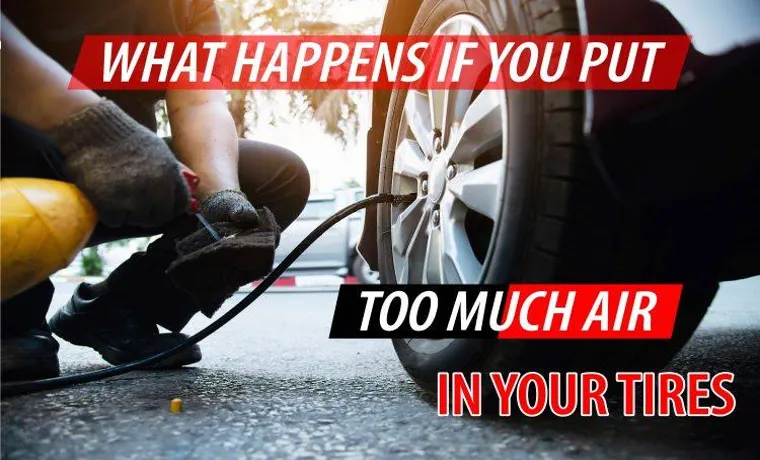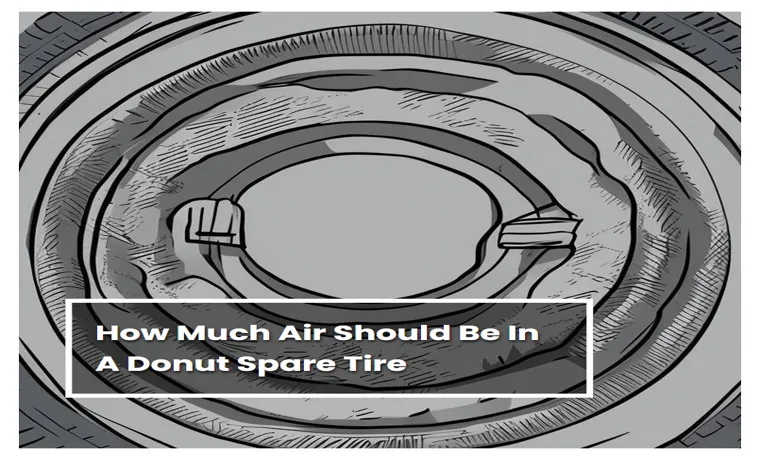Have you ever heard of donut tires? These compact spare tires are designed to get you out of a tricky situation when your full-sized tire fails unexpectedly. But do you know how to properly inflate them? Many drivers don’t, which can lead to problems down the road. In this blog, we’ll dive into the world of donut tires and explore the importance of proper inflation.
Think of it like blowing up a balloon – if you don’t inflate it just right, it won’t function properly. The same goes for donut tires. So, let’s get started and ensure that you’re driving safely on the road!
Table of Contents
Donut Tires 101
If you’ve ever had a flat tire and used the spare donut tire as a temporary replacement, you might wonder how much air should be put in it. Donut tires are designed to be smaller and lighter than regular tires, meaning they require less air pressure. Generally, the proper air pressure for a donut tire is between 60-80 psi (pounds per square inch).
However, it’s always best to check your car’s owner manual or the tire itself for the manufacturer’s recommended pressure. It’s important to note that driving on a donut tire for an extended period can be dangerous and can cause damage to your car’s suspension system. Ultimately, it’s best to replace the damaged tire with a new one as soon as possible.
What is a Donut Tire?
Donut tire, also known as a spare tire, is a temporary tire that is designed to get you back on the road in case of a flat tire. It’s much thinner and smaller than a typical tire, which means it’s not suitable for long-distance driving or high speeds. The purpose of a donut tire is to get you to a nearby mechanic or tire shop where you can safely replace your flat tire with a new one.
Donut tires are usually kept in the trunk of the car and are easy to install, but it’s important to read the instructions and ensure it’s put on correctly. Donut tires should only be used as a temporary solution and not driven on for an extended period. It’s crucial to replace your damaged tire as soon as possible to avoid any unsafe driving conditions.
Overall, having a donut tire in your car can bring peace of mind knowing you have a backup plan in case of an emergency.

Why are Donut Tires Used?
Donut Tires Donut tires, also known as space-saver tires, are small, lightweight spare tires that are often used as a temporary solution when your vehicle has a flat tire or another puncture. They are called donut tires because of their distinctive shape, which is similar to that of a donut. Donut tires are designed to be compact and take up minimal space in your vehicle, making them ideal for emergencies.
They are typically narrower than regular tires, which means that they don’t provide the same amount of stability or good grip on the road. Because of this, it is recommended that you only use donut tires for short distances and at lower speeds. Despite their limitations, donut tires are still used because of their convenience and affordability compared to full-sized spare tires.
However, it is always better to have a full-sized spare tire ready to go in case of emergency, rather than relying on a donut tire. So, make sure to check your vehicle’s spare tire before you hit the road!
Finding the Correct PSI for Your Donut Tire
If you find yourself with a donut spare tire, it’s important to know the correct PSI to inflate it to before hitting the road. Generally, a donut tire is designed to be used temporarily and is not meant for extended periods of use. The recommended PSI for a donut spare tire can usually be found in the owner’s manual or on a sticker located on the driver’s side door jamb.
It’s essential to follow the manufacturer’s recommendation as underinflation can lead to poor handling and overinflation can cause a blowout. On average, the recommended PSI for a donut tire is often between 60-80 PSI, but it’s crucial to double-check as different vehicles can have different requirements. Remember, transition your safety is important, so if you are ever unsure about what PSI to inflate your spare tire to, consult a professional or your vehicle’s manual.
Checking the Owner’s Manual
When faced with a flat tire, it’s important to know how much air pressure to put in your donut tire. The correct PSI for your spare tire can usually be found in the owner’s manual that came with your car. It’s important to note that the recommended PSI for your donut tire may be different than your regular tires, so always double-check before filling it up.
If you can’t find the information in your manual, you can also check the tire itself for any markings or labels that indicate the proper air pressure. Remember, driving on an underinflated donut tire can be dangerous, so it’s crucial to take the time to find the correct PSI and fill it up properly before hitting the road.
Locating the Tire Sidewall Information
When it comes to finding the correct PSI (pounds per square inch) for your donut tire, it’s important to locate the tire sidewall information. This information can typically be found on the outer surface of the tire and includes details such as the tire size, load index, speed rating, and of course, the recommended PSI. The recommended PSI for your donut tire will depend on a number of things, including the type of vehicle you drive and the weight that your tire can safely support.
It’s important to note that overinflating or underinflating your donut tire can lead to decreased performance and even unsafe driving conditions. So, take the time to locate the tire sidewall information and ensure that you’re inflating your donut tire to the recommended PSI. Doing so will ensure that your vehicle is running smoothly and safely, even in emergency situations.
Inflating Your Donut Tire
When it comes to inflating your donut tire, there are a few things to keep in mind. The first and most important is to check your vehicle’s owner manual for the recommended tire pressure. Most donut tires require a higher PSI than regular tires, so you don’t want to overinflate or underinflate it.
The next step is to use a tire pressure gauge to ensure that you are inflating the tire to the correct pressure. Insert the gauge into the valve stem on the tire and read the pressure on the gauge. If the pressure is too low, use an air compressor to add more air in small increments until it reaches the recommended pressure.
If the pressure is too high, simply release some air until it reaches the recommended level. Keep in mind that donut tires are meant to be used as temporary spares and should not be driven on for extended periods. Always replace the tire with a regular one as soon as possible.
Materials and Tools Needed
When it comes to inflating your donut tire, you’ll need a few key materials and tools to get the job done right. Firstly, you’ll need a tire pressure gauge to ensure that you don’t overinflate or underinflate your tire. This will help you to maintain the proper air pressure for your specific vehicle.
Next, you’ll need an air compressor or tire inflator. These tools can either be electric or manual, and they’ll make it easy to add air to your tire quickly and efficiently. You may also want to have some tire sealant or flat tire repair kits on hand just in case you run into any issues while inflating your tire.
And lastly, don’t forget to grab a valve stem remover tool to help you get access to the valve stem. With these materials and tools, you’ll be well-equipped to inflate your donut tire and get back on the road safely and quickly.
Steps for Inflation
Inflating your donut tire can be a daunting task, especially if you’re not familiar with the steps. Firstly, you need to make sure you’re in a safe and stable environment where your car won’t roll or shift. Then, retrieve the spare tire, lug wrench, and jack, and position the jack beneath the car’s designated jacking points.
Raise the car until the damaged tire clears the ground and remove the lug nuts. After that, you can use a foot pump or tire inflator to inflate your donut tire to the recommended PSI specified in your car manual. Finally, replace the lug nuts in a star pattern, lower the car back onto the ground, and tighten the lug nuts with your lug wrench.
Remember to check the pressure regularly and don’t exceed the recommended PSI to avoid further damaging the tire. With these simple steps, you can get your car back on the road safely.
Final Thoughts
When it comes to donut tires, it’s crucial to know how much air to put in them. These compact spare tires are not intended for long-term use and have limited capabilities compared to regular tires. The recommended air pressure can typically be found in your vehicle manual or on a sticker inside the driver’s door frame.
Most donut tires require a higher pressure than regular tires, typically around 60 psi. However, it is important to never exceed the maximum pressure listed on the tire itself. Overinflated tires can be just as dangerous as under-inflated ones and may cause a blowout or other damage.
It’s important to regularly check and maintain the correct air pressure in your donut tire to ensure it performs safely and effectively in a time of need.
Conclusion
Well, my dear friends, it seems that putting air in a donut tire is much like life itself – there is no one-size-fits-all answer! Depending on the make and model of your vehicle, the recommended air pressure can vary greatly. And just as we navigate the twists and turns of life, we must carefully navigate the roads with our properly inflated donut tires. So, remember to always check your vehicle’s manual and use a reliable tire pressure gauge to ensure your safety and the longevity of your trusty donut tire.
And above all, keep a sense of humor and joy when faced with life’s unexpected bumps in the road – after all, even a donut tire can keep us moving forward!
FAQs
What is a donut tire and when should it be used?
A donut tire, also known as a spare tire, is a temporary tire designed to get you to a repair shop to replace the damaged tire. It should only be used for a short distance and at a reduced speed.
How do I know how much air to put in my donut tire?
The recommended air pressure for your donut tire can usually be found on the tire itself or in your car’s owner manual. It is typically higher than your regular tires, so make sure to check and adjust accordingly.
Can I drive on a donut tire for an extended period of time?
No, a donut tire should only be used as a temporary solution and for a very short distance. It is not designed for prolonged or high-speed driving.
How long can I drive on a donut tire before I need to replace it?
It is recommended to replace your donut tire as soon as possible after using it. It is not meant to be a permanent tire replacement and can cause damage to your car’s suspension and handling if driven on for too long.
Do all cars come with a donut tire?
No, not all cars come with a donut tire. Some newer cars may come with a tire repair kit instead of a spare tire.
Can I repair a punctured donut tire?
It is not recommended to repair a donut tire, as these tires are not designed to withstand the rigors of repair and may not be reliable in the future. It is best to replace the tire if it has been punctured.
How does a donut tire affect my car’s handling?
Donut tires are not designed to handle like standard tires and may cause your car’s handling to feel different. It is important to drive slowly and cautiously with your donut tire to prevent any accidents or damage to your car.



